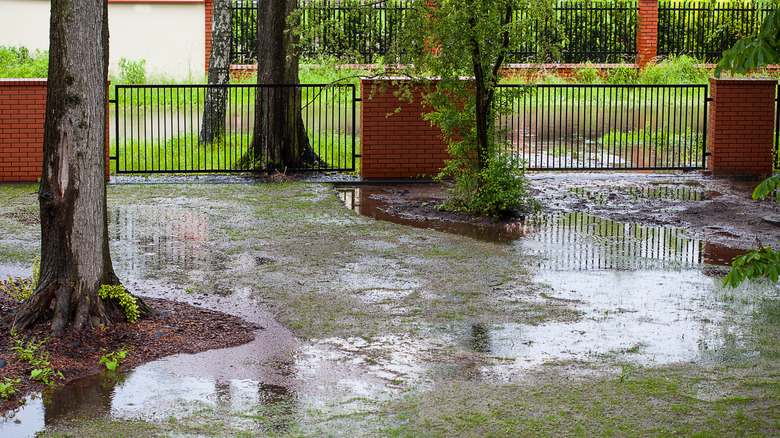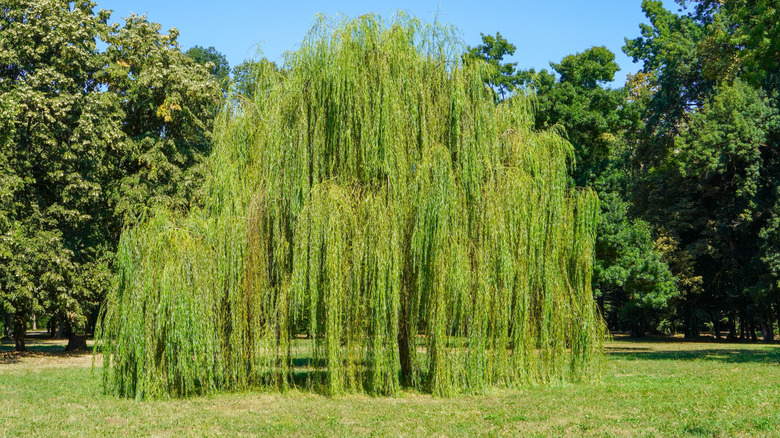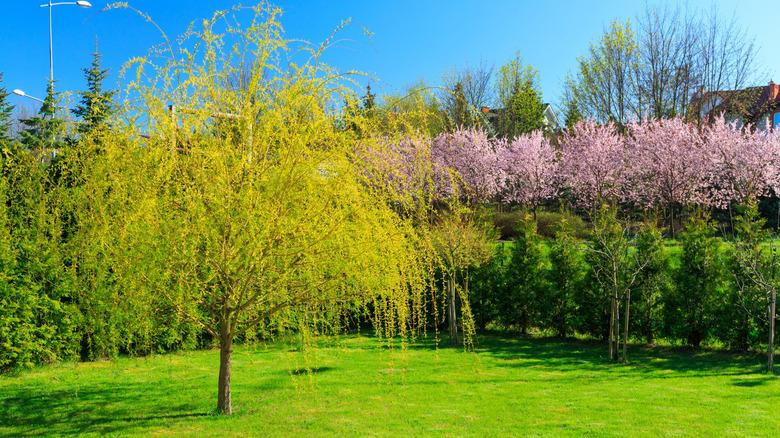The Beautiful (And Thirsty) Tree That'll Absorb Excess Water In Your Yard
If you've ever struggled with a persistently wet yard or areas prone to standing water, you know how frustrating it can be to manage. Be it from large amounts of rainfall, insufficient drainage, or a high water table, these soggy spots can quickly result in unattractive mud holes. While some homeowners turn to expensive landscaping options, there is a natural solution that does it with grace and puts a smile on your face: the weeping willow tree (Salix babylonica).
This elegant tree, with its drooping branches and fuller foliage, thrives in moist areas and absorbs all the water out of wet, low areas. It not only beautifies your yard but also serves a practical purpose in regulating excessive moisture. In this article, we'll discuss why the weeping willow thrives in wet locations, how to grow and care for weeping willow trees, and some things to keep in mind before planting one.
How the weeping willow thrives in wet conditions
The weeping willow is uniquely suited to wet environments thanks to its fast-growing roots and moisture-loving nature. Unlike many trees that struggle in waterlogged soil, this species thrives, even in areas where other plants fail. Its substantial root system efficiently soaks up large amounts of water, acting like a sponge for soggy patches.
Weeping willows do best in USDA hardiness zones 6 through 8, where the climate supports their growth and moisture needs. These zones usually have moderate winters and sufficient rainfall that aligns with the tree's preferences. Additionally, the weeping willow grows fast, reaching up to 50 feet tall at maturity. Its broad canopy offers shade, making it most appropriate for those with larger yards. There is no denying the tree's aesthetic value, but beauty is not the only reason this tree is a huge favorite for wet areas.
By absorbing the water, the weeping willow helps prevent standing water, so there is less opportunity for mosquitoes to breed and soil erosion to occur. It is a convenient and eco-friendly method of overcoming drainage issues. Keep in mind that in some regions, like Virginia, the weeping willow is considered an invasive species due to its fast growth and aggressive root systems that can damage local ecosystems. Before you plant, contact your local extension office or environmental agency to be sure that introducing this tree meets the guidelines for your area.
Things to know before you plant a weeping willow
While it does have many benefits, there are some things to watch out for if there's a weeping willow in your yard. One of the most important factors to consider is its invasive root system, which expands quickly and can potentially cause damage to nearby infrastructure, such as septic systems, pipes, or sidewalks. So you'll want to avoid planting these popular trees too close to your house and, ideally, plant 50 feet or more away from all structures or buried utilities.
Choose a location with full sun. While it can tolerate bouts of standing water, well-draining soil encourages healthy growth. Although wind-tolerant, young trees benefit from some protection while establishing. The best time to plant is in early spring or fall. Dig a hole twice as wide as the root ball, ensuring the hydrated tree sits at the same depth as in its nursery container. Fill with soil, water deeply, and apply mulch to retain moisture. Regular watering is essential for young trees, especially during dry periods. Once mature, the tree can tolerate occasional droughts but still thrives with consistent moisture.
Because it grows quickly, it needs to be pruned frequently to maintain a neat appearance and prevent overgrowth, which could lead to large limb breakage. Plus, since the tree can drop leaves and small branches, expect periodic cleanups of the yard. Common pests include aphids and caterpillars, while diseases like willow blight and powdery mildew can occur. Monitor for signs of trouble and take early action to keep the tree healthy.


